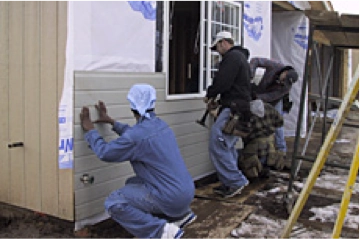Housing Stock Characteristics
The analysis of housing stock characteristics must include an estimate of the number of substandard units in need of rehabilitation and/or replacement. This information will assist local governments in developing appropriate housing policies and prioritizing housing resources.
Government Code

Government Code Section 65583(a) requires an analysis and documentation of household characteristics, including level of payment compared to ability to pay, housing characteristics, including overcrowding, and housing stock condition, (Section 65583 (a)(2)).
Requisite Analysis
Housing Conditions
Estimate the total number of substandard units — e.g. those in need of rehabilitation (repair) and those in need of replacement (demolition). The number of units to be rehabilitated and/or replaced may be estimated from a recent (e.g., the last five years) windshield survey or sampling, estimates from the local building department, knowledgeable builders/developers in the community, or nonprofit housing developers or organizations. Estimates can also be derived from U.S. Census data, such as percentage of units built before 1980. However, U.S. Census data only serves as an estimate of the maximum rehabilitation need and should be supplemented by local estimates.
Sample Housing Condition Surveys
Sample housing condition survey (PDF) from the Community Development Block Grant (CDBG) program
Sample Tables
| Housing Condition Survey | ||||||
|---|---|---|---|---|---|---|
| Housing Type | Sound | Minor | Moderate | Substantial | Dilapidated | Total |
| Single | ||||||
| Mobile | ||||||
| Duplex | ||||||
| Multifamily | ||||||
| Total | ||||||
| Percent | ||||||
| Source: City staff survey | ||||||
| Year Structure Built | |
|---|---|
| Year Built | Number |
| Built 1999 through 2012 | |
| Built 1995 through 1998 | |
| Built 1990 through 1994 | |
| Built 1980 through 1989 | |
| Built 1970 through 1979 | |
| Built 1960 through 1969 | |
| Built 1950 through 1959 | |
| Built 1940 through 1949 | |
| Built 1939 or earlier | |
| Total | |
Source: U.S. Census American Community Survey Year Structure Built (Table: B25034)
| Year Structure Built: U.S. Census Tracts | ||||
|---|---|---|---|---|
| Census Tract # | Built 1999 to Current | 1970 through 1999 | Before 1970 | Total Housing Units |
Source: U.S. Census American Community Survey, Year Structure Built (Table: B25034)
Housing Stock Characteristics
The housing element should include a description and analysis of current housing stock characteristics. This information can be used to assist jurisdictions in identifying specific housing needs and tailoring housing programs to fit those needs. Where available, information on tenure (rental or ownership) should be included. This information can be useful because tenure affects the nature of housing problems encountered, as well as the programs or resources that have the potential to address them. The housing element should include information regarding:
Housing costs and affordability
- U.S. Census American Community Survey, B25075, Value (Universe: Owner-occupied housing units)
- U.S. Census American Community Survey, B25077, Median value (dollars) (Universe: Owner-occupied housing units)
- U.S. Census 2000, Summary File 3, H76, Median value (dollars), specified owner-occupied housing units, Summary File 3, H63, Median gross rent (dollars)
- U.S. Census American Community Survey, B25058, Median contract rent (dollars) (Universe: renter-occupied housing units paying cash rent B25077. Median value (dollars) (Universe: Owner-occupied housing units)
Housing construction prices and trends
- Construction Industry Research Board, Building Permit Summary, California Cities and Counties Data, Calendar Years 1999-2006.
- Press releases from the California Association of Realtors can provide information on housing prices.
- Current market rents can be collected through a phone survey of properties within the jurisdictions, surveying rental magazines or online searches for rent information, and/or through a survey of property management companies.
Housing units by type
- American Community Survey, B25024, Units in structure
Vacancy rates
- American Community Survey, B25004, Vacancy Status (Universe: Vacant housing units)
- Census 2000 Summary File 3, H6 Occupancy status, H8 Vacancy status
- 2006 U.S. Census American Community Survey,* B25002, Occupancy status, B25004, Vacancy status
*Data from the American Community Survey are available for geographic areas with a population of 65,000 or more for yearly survey; all areas are counted in the five-year estimates.
Sample Tables
| Median Value/Rent 1990-2000 | ||||||
|---|---|---|---|---|---|---|
| Value/Rent | 2000 | 2012 | 2000-2012 Percent Change | ACS 2007 | ACS Margin of Error | 2000-2012 Percent Change |
| Median Home Value | ||||||
| Median Gross Rent | ||||||
Sources:
U.S. Census 2000
- Summary File 3, H76, Median value (dollars) for specified owner-occupied housing units
- Summary File 3, H63, Median gross rent (dollars)
U.S. Census 1990
- Summary File 3, H061A, Median value - specified owner-occupied housing units
- H043A, Median gross rent - specified renter-occupied housing units paying cash rent
U.S. Census American Community Survey
- B25058, Median contract rent (dollars) - renter-occupied housing units paying cash rent
- B25077, Median value (dollars) - owner-occupied housing units
| Current Median Rents | |
|---|---|
| Bedroom Type | Median Market Rents |
| Studio | |
| One-Bedroom | |
| Two-Bedroom | |
| Three-Bedroom | |
| Four-Bedroom | |
Note: Current market rents can be collected through a phone survey of properties within the jurisdictions, surveying rental magazines, or online searches for rent information, and/or through a survey of property management companies.
| Regional Median Home Values | |||
|---|---|---|---|
| City | Median Value | Percent Change | |
| Aug-09 | Aug-10 | ||
| City B | |||
| City R | |||
Source: California Association of Realtors
| Housing Units by Type | ||||||
|---|---|---|---|---|---|---|
| 2000 | 2010 | Change | ||||
| Unit Type | Number | Percent | Number | Percent | Number | Percent |
| Single-Family | ||||||
| Duplex | ||||||
| 3-4 Units | ||||||
| 5+ Units | ||||||
| Mobilehome and Other | ||||||
| Totals | ||||||
Source:
U.S. Census American Community Survey, B25024, Units in structure
U.S. Census 2000 Summary File 3, H30, Units in structure
U.S. Census 1990 Summary Tape File 3, H020, Units in structure
| Housing Units by Type | ||||||
|---|---|---|---|---|---|---|
| 2010 | Current Year | Change | ||||
| Unit Type | Number | Percent | Number | Percent | Number | Percent |
| Single-Family | ||||||
| Duplex | ||||||
| 3-4 Units | ||||||
| 5+ Units | ||||||
| Mobilehome and Other | ||||||
| Totals | ||||||
Source: California Department of Finance E-5 County/State Population and Housing Estimates
| Housing Permits Issued (2006 – CURRENT) | ||||
|---|---|---|---|---|
| Single-Family | 2-4 units | 5+ Units | TOTAL | |
| 2006 | ||||
| 2007 | ||||
| 2008 | ||||
| 2009 | ||||
| 2010 | ||||
| 2011 | ||||
| 2012 | ||||
| 2013 | ||||
| 2014 | ||||
Source: Construction Industry Research Board, Building Permit Summary, California Cities and Counties Data
| Pending Housing Developments | ||||
|---|---|---|---|---|
| Developer/Development Name | Number/Type of Units | Unit Size (sq. ft.) | Price Range | Status |
| Status: C = Complete, UC = Under Construction, A = Approved (Tentative or Final Map) | ||||
Sources: City, and discussions with developers
| Vacancy Rates | |
|---|---|
| 2012 American Community Survey | |
| Total: | |
| Occupied | |
| Vacant | |
| For rent | |
| Rented, not occupied | |
| For sale only | |
| Sold, not occupied | |
| For seasonal, recreational, or occasional use | |
| For migrant workers | |
| Other vacant | |
Source: U.S. Census American Community Survey, B25002, Occupancy status, B25004, Vacancy Status

